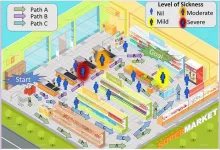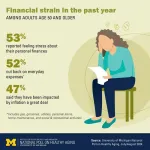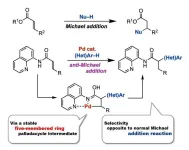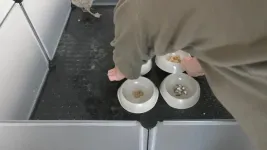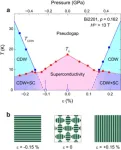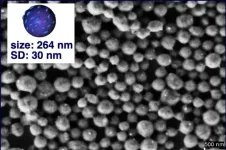(Press-News.org) A group of scientists have released a landmark report on glacial geoengineering—an emerging field studying whether technology could halt the melting of glaciers and ice sheets as climate change progresses.
The white paper represents the first public efforts by glaciologists to assess possible technological interventions that could help address catastrophic sea-level rise scenarios.
While it does not endorse any specific interventions, it calls for a “major initiative” in the next decades to research which, if any, interventions could and should be used.
“Everyone who is a scientist hopes that we don’t have to do this research,” said Douglas MacAyeal, a professor of geophysical sciences with the University of Chicago who has studied glaciers for nearly 50 years and is a co-author on the white paper. “But we also know that if we don’t think about it, we could be missing an opportunity to help the world in the future.”
The paper is the result of two recent conferences at the University of Chicago and Stanford University on geoengineering—catalyzed and encouraged by the newly formed Climate Systems Engineering initiative at UChicago, which seeks to understand the benefits, risks, and governance of technologies that might reduce the impacts of accumulated greenhouse gases.
Tipping points
Scientists have documented major changes in every major glacier system worldwide. As climate change continues, these massive ice sheets will release more and more water, which will lead to rising global sea levels—the oceans have already risen by 8 to 9 inches since the late 1800s.
Most of the ice that would affect global sea levels is concentrated in a few areas in the Arctic and Antarctic. This has prompted speculation whether it would be possible to slow or halt this melting, such as by installing walls around ice sheets to insulate them from warming ocean water.
But any such intervention could have major consequences, ranging from costing large amounts of money for little effect to majorly disturbing Arctic ecosystems and livelihoods—and there are many questions to answer before any such effort could be undertaken.
“It will take 15 to 30 years for us to understand enough to recommend or rule out any of these interventions,” said co-author John Moore, a professor with the Arctic Center at the University of Lapland.
“Our argument is that we should start funding this research now, so that we aren’t making panicked decisions down the road when the water is already lapping at our ankles,” said MacAyeal.
The report is also clear that the first order of business is to stop emitting carbon into the atmosphere. “We can never say often enough that that is the first priority,” said Moore.
But it is also possible that ice sheets have a tipping point for collapsing—and that we have already passed it.
“Humans have already released so much carbon dioxide that we are seeing profound changes in every glacier system around the world,” said MacAyeal. “Many of these are likely to have a tipping point where even if we were to stop emitting all carbon worldwide tomorrow, the system would still collapse. And we are not in a position now to say that we haven’t already crossed those points.”
Types of interventions
The two conferences, one held at the University of Chicago last October and the other at Stanford University in December, brought together dozens of glaciologists, engineers and related disciplines.
The participants summarized our current knowledge of glacier science, and discussed two major categories of glacier interventions that have been proposed to date.
The first category consists of some type of berms or fiber-based “curtains” moored on the seabed around the feet of ice shelves, which would prevent warm water from undermining them. (The biggest threat to ice sheets is actually warmer ocean water, rather than hotter air temperatures.)
“From preliminary studies, the actual engineering required might be smaller than you might think,” said MacAyeal. “For example, the Thwaites Glacier in Antarctica might require as little as 50 miles of seabed nets and curtains to make a difference.”
The other major category of intervention is trying to slow the flow of streams that carry meltwater off the ice sheets. As an ice sheet melts, streams form and carry that melting water to the sea; the hypothesis is that reducing the amount of that water would cause the ice stream to freeze up and halt melting. One way to reduce the flow might be to drill holes down to the glacier bed—to either drain water from below the ice before it affects the glacier, or to try to artificially freeze the glacier bed.
But both benefits and drawbacks remain unclear for both sets of approaches, scientists said. It’s possible that seawalls could simply deflect warm water to nearby ice shelves; the installation also would disrupt local sea life and the lives of people who live nearby. Meanwhile, the drilling approach might be less harmful to ecosystems, but it might also not be very effective, and would require a lot of engineering under harsh conditions.
The report also emphasizes that any such interventions would need to be conducted with input from nations worldwide, not just the wealthiest. It calls for “robust participation of sociologists, humanists, ecologists, community leaders, scientific and engineering governing bodies, international treaty organizations, and other relevant stakeholders in guiding the research.”
In particular, testing these approaches is most likely to be done in the Arctic, which is orders of magnitude easier to access than the Antarctic. But thousands of people live in and depend on the Arctic, including many Indigenous peoples. “It is imperative that any of these interventions be done in concert with these voices,” Moore said.
‘Vigorous debate’
The report identifies major areas of research for the future, including identifying what natural processes might limit ice sheet deterioration and human interventions that could enhance those processes; and what the window of opportunity for implementing interventions might be.
The group called for a major initiative which would conduct “vigorous debate” of the ethical, social justice, and governance of glacial interventions, recommend areas of immediate research need, and engage local and international stakeholders.
“We want to give future generations as much glaciological knowledge as possible in case they need it,” said MacAyeal
The full white paper is available online.
END
Scientists call for ‘major initiative’ to study whether geoengineering should be used on glaciers
Report finds many questions remain around technology to address glacier melting and sea-level rise
2024-07-11
ELSE PRESS RELEASES FROM THIS DATE:
Mount Sinai secures over $4 million grant from National Institutes of Health to study alopecia areata and atopic dermatitis in people with Down Syndrome
2024-07-11
New York, NY (July 11, 2024) – The Icahn School of Medicine at Mount Sinai is embarking on biomedical research aiming to set new standard-of-care protocols for treating alopecia areata and atopic dermatitis in people with Down syndrome, or trisomy 21.
Emma Guttman-Yassky, MD, PhD, the Waldman Professor and Chair of Dermatology at Icahn Mount Sinai, has been awarded more than $4 million for a five-year National Institutes of Health (NIH) R61/R33 grant to evaluate the long-term safety, efficacy, and mechanisms of medications known as JAK inhibitors in patients with Down syndrome. The medications have been approved ...
How risk-averse are humans when interacting with robots?
2024-07-11
How do people like to interact with robots when navigating a crowded environment? And what algorithms should roboticists use to program robots to interact with humans?
These are the questions that a team of mechanical engineers and computer scientists at the University of California San Diego sought to answer in a study presented recently at the ICRA 2024 conference in Japan.
“To our knowledge, this is the first study investigating robots that infer human perception of risk for intelligent decision-making in everyday settings,” said Aamodh Suresh, first author of the study, who earned his Ph.D. in the research group of Professor Sonia Martinez Diaz ...
An unequal toll of financial stress: Poll of older adults shows different impacts related to health and age
2024-07-11
Inflation rates may have cooled off recently, but a new poll shows many older adults are experiencing financial stress – especially those who say they’re in fair or poor physical health or mental health.
Women and those age 50 to 64 are more likely than men or people over age 65 to report feeling a lot of stress related to their personal finances. So are people age 50 and older who say they’re in fair or poor physical or mental health.
In all, 47% of people age 50 and older said inflation had impacted them a great deal in the past year, and 52% said they ...
One-step synthesis of pharmaceutical building blocks: new method for anti-Michael reaction
2024-07-11
In 1887, chemist Sir Arthur Michael reported a nucleophilic addition reaction to the β-position of α,β- unsaturated carbonyl compounds. These reactions, named Michael addition reactions, have been extensively studied to date. In contrast, the anti-Michael addition reaction, referring to the nucleophilic addition reaction to the α-position, has been difficult to achieve. This is due to the higher electrophilicity of the β-position compared to the α-position. Previous attempts to overcome these difficulties have involved two main methods. The first is restricting the addition position via intramolecular reactions, ...
Urban seagulls still prefer seafood
2024-07-11
Seagull chicks raised on an “urban” diet still prefer seafood, new research shows.
University of Exeter scientists studied herring gull chicks that had been rescued after falling off roofs in towns across Cornwall, UK.
Raised in captivity (before being released), they were given either a “marine” diet consisting mainly of fish and mussels, or an “urban” diet containing mostly bread and cat food.
Every few days the gull chicks were presented with a choice of all four foods in different bowls, to test which they preferred – and all gulls strongly favoured fish.
“Our results suggest that, even when reared on an ‘urban’ ...
Understanding the origin of superconductivity in high-temperature copper oxide superconductors
2024-07-11
Superconductors are materials that can conduct electricity with zero resistance when cooled to a certain temperature, called the critical temperature. They have applications in many fields, including power grids, maglev trains, and medical imaging. High-temperature superconductors, which have critical temperatures higher than normal superconductors have significant potential for advancing these technologies. However, the mechanisms behind their superconductivity remain unclear.
Copper oxides or cuprates, a class of high-temperature superconductors, exhibit superconductivity ...
Shaping the future of polymer nanocarriers
2024-07-11
Scientists have taken a significant step towards the development of tailor-made chiral nanocarriers with controllable release properties. These nanocarriers, inspired by nature's helical molecules like DNA and proteins, hold immense potential for targeted drug delivery and other biomedical applications.
The study, led by Professors Emilio Quiñoá and Félix Freire at the Center for Research in Biological Chemistry and Molecular Materials (CiQUS), highlights the intricate relationship between the structure of helical polymers and their self-assembly into nanospheres. By carefully designing ...
2000th ERC Proof of Concept grant awarded
2024-07-11
The grants – each worth €150,000 – help researchers to bridge the gap between the discoveries stemming from their frontier research and the practical application of the findings, including early phases of their commercialisation.
Nanda Rea’s new project, called DeepSpacePULSE, aims to facilitate deep space exploration. Currently, to find their way, spacecraft and satellites use up a lot of energy exchanging vital navigation information with mission coordinators on Earth. Using ERC Proof of Concept funding, Prof. Nanda Rea ...
Wild plants and crops don’t make great neighbors
2024-07-11
Native plants and non-native crops do not fare well in proximity to one another, attracting pests that spread diseases in both directions, according to two new UC Riverside studies.
“We have changed the landscape, and it’s created opportunities for pathogens to thrive,” said UCR entomologist Kerry Mauck, who co-authored the studies. “We have introduced pathogens that damage native plants, and on the other side of the coin we have endemic pathogens that mutate to infect ...
Movement sensors show promise in identifying horses at injury risk
2024-07-11
PULLMAN, Wash. – A small 3-ounce sensor capable of recording 2,400 data points of movement in just one second being tested and refined by researchers at Washington State University could be key in reducing the number of injuries to racehorses.
Led by Dr. Warwick Bayly in WSU’s College of Veterinary Medicine, researchers used the biometric sensors, developed by the company StrideSAFE, to track thoroughbreds as they raced and trained at some of the top racetracks in the country. Using collected data, the team was able to identify miniscule stride changes associated with increased risk ...
LAST 30 PRESS RELEASES:
Boosting the cell’s own cleanup
Movement matters: Light activity led to better survival in diabetes, heart, kidney disease
Method developed to identify best treatment combinations for glioblastoma based on unique cellular targets
Self-guided behavioral app helps children with epilepsy sleep earlier
Higher consumption of food preservatives is associated with an increased risk of type 2 diabetes
NTU Singapore-led team captures first-ever ‘twitch’ of the eye’s night-vision cells as they detect light, paving the way for earlier detection of blindness-causing diseases
Global aviation emissions could be halved through maximising efficiency gains, new study shows
Fewer layovers, better-connected airports, more firm growth
Exposure to natural light improves metabolic health
As we age, immune cells protect the spinal cord
New expert guidance urges caution before surgery for patients with treatment-resistant constipation
Solar hydrogen can now be produced efficiently without the scarce metal platinum
Sleeping in on weekends may help boost teens’ mental health
Study: Teens use cellphones for an hour a day at school
After more than two years of war, Palestinian children are hungry, denied education and “like the living dead”
The untold story of life with Prader-Willi syndrome - according to the siblings who live it
How the parasite that ‘gave up sex’ found more hosts – and why its victory won’t last
When is it time to jump? The boiling frog problem of AI use in physics education
Twitter data reveals partisan divide in understanding why pollen season's getting worse
AI is quick but risky for updating old software
Revolutionizing biosecurity: new multi-omics framework to transform invasive species management
From ancient herb to modern medicine: new review unveils the multi-targeted healing potential of Borago officinalis
Building a global scientific community: Biological Diversity Journal announces dual recruitment of Editorial Board and Youth Editorial Board members
Microbes that break down antibiotics help protect ecosystems under drug pollution
Smart biochar that remembers pollutants offers a new way to clean water and recycle biomass
Rice genes matter more than domestication in shaping plant microbiomes
Ticking time bomb: Some farmers report as many as 70 tick encounters over a 6-month period
Turning garden and crop waste into plastics
Scientists discover ‘platypus galaxies’ in the early universe
Seeing thyroid cancer in a new light: when AI meets label-free imaging in the operating room
[Press-News.org] Scientists call for ‘major initiative’ to study whether geoengineering should be used on glaciersReport finds many questions remain around technology to address glacier melting and sea-level rise

